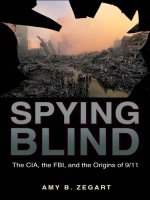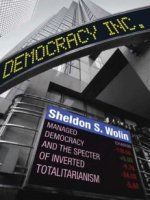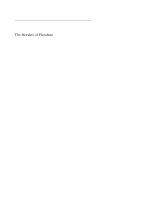princeton university press spying blind the cia the fbi and the origins of 9 11 aug 2007
Bạn đang xem bản rút gọn của tài liệu. Xem và tải ngay bản đầy đủ của tài liệu tại đây (1.07 MB, 336 trang )
Spying Blind
N
This page intentionally left blank
Spying Blind
The CIA, the FBI, and the Origins of 9/11
N
AMY B. ZEGART
PRINCETON UNIVERSITY PRESS
PRINCETON AND OXFORD
Copyright © 2007 by Princeton University Press
Published by Princeton University Press, 41 William Street,
Princeton, New Jersey 08540
In the United Kingdom: Princeton University Press, 3 Market Place,
Woodstock, Oxfordshire OX20 1SY
All Rights Reserved
Library of Congress Cataloging-in-Publication Data
Zegart, Amy, 1967–
Spying blind : the CIA, the FBI, and the origins of 9/11 / Amy B. Zegart.
p. cm.
Includes bibliographical references and index.
ISBN: 978-0-691-12021-8
1. Intelligence service—United States. 2. United States. Central
Intelligence Agency. 3. United States. Federal Bureau of Investigation.
4. September 11 Terrorist Attacks, 2001. 5. Terrorism—Government
policy—United States. I. Title.
JK468.I6Z42 2007
973.931——dc22 2006103325
British Library Cataloging-in-Publication Data is available
This book has been composed in Palatino
Printed on acid-free paper. ∞
press.princeton.edu
Printed in the United States of America
13579108642
For my children:
Alexander, Jack, and Kate
N
This page intentionally left blank
N Contents N
Acknowledgments xiii
CHAPTER ONE
An Organizational View of 9/11 1
CHAPTER TWO
Canaries in the Coal Mine: The Case for Failed Adaptation 15
CHAPTER THREE
Crossing an Academic No-Man’s Land:
Explaining Failed Adaptation 43
CHAPTER FOUR
Fighting Osama One Bureaucrat at a Time:
Adaptation Failure in the CIA 61
CHAPTER FIVE
Signals Found and Lost: The CIA and 9/11 101
CHAPTER SIX
Real Men Don’t Type: Adaptation Failure in the FBI 120
CHAPTER SEVEN
Evidence Teams at the Ready: The FBI and 9/11 156
CHAPTER EIGHT
The More Things Change . . . 169
APPENDIX
Intelligence Reform Catalog Methodology 199
Notes 203
References 273
Index 309
This page intentionally left blank
N Tables N
Table 2.1 Islamist Terrorist Attacks and Plots against
Americans Known to U.S. Intelligence Officials
before September 11, 2001 23–24
Table 2.2 Unclassified U.S. Intelligence and
Counterterrorism Studies, 1991–2001 29
Table 2.3 Intelligence Focus of All Reform Studies,
1991–2001 32
Table 2.4 Intelligence Focus of Counterterrorism and
Law Enforcement Studies versus Others, 33
1991–2001
Table 2.5 Commonly Identified Organizational
Problems in Intelligence, 1991–2001 39
Table 6.1 Criminal Focus of FBI Presidential Rank
Award Winners, 1992–2001 150
This page intentionally left blank
N Figures N
Figure 2.1 Intelligence Focus of Reform Study
Recommendations, 1991–2001 30
Figure 2.2 Implementation of Intelligence Reform
Recommendations, 1991–2001 36
Figure 4.1 The CIA and 9/11: The Organizational Roots
of Failure 64
Figure 5.1a President’s Daily Brief, August 6, 2001 110
Figure 5.1b President’s Daily Brief, August 6, 2001 111
Figure 5.2a Timeline of the CIA’s 11 Missed Opportunities 116
Figure 5.2b Timeline of the CIA’s 11 Missed Opportunities 117
Figure 6.1 The FBI and 9/11: The Organizational Roots of
Failure 122
Figure 6.2 Comparison of FBI Presidential Rank Awards,
Early versus Late 1990s 151
Figure 7.1a Timeline of the FBI’s 12 Missed Opportunities 164
Figure 7.1b Timeline of the FBI’s 12 Missed Opportunities 165
This page intentionally left blank
N Acknowledgments N
FOR YEARS, I have been fascinated by the dark side of organiza-
tions,
1
and one puzzle in particular: why U.S. foreign policy
agencies cannot adapt easily to new challenges. In 1999, my ini-
tial idea was to write a book comparing how well different agen-
cies responded to the end of the Cold War. But two problems
quickly stumped me. The first was the absence of much varia-
tion across agencies. When I asked a number of senior officials
and experts which U.S. foreign policy agencies had adapted bet-
ter than others, the response was universal: none had done par-
ticularly well. The second problem was that adaptation was too
vague a concept. I needed a set of facts on the ground, a dra-
matic event that would enable me to pinpoint a major new
threat and trace how well America’s foreign policy machinery
had responded to it.
Then came September 11th. Like most Americans, I can still
vividly picture that day. I remember standing stunned in my
kitchen as the World Trade Center towers collapsed on televi-
sion. I remember watching my son, Jack, take his first steps and
wondering how his world would differ from my own Cold War
childhood. And I remember thinking that this was the event I
had to examine.
The journey has been a long one, with many people to thank.
Above all, I would like to express my deepest gratitude to the
seventy-five current and former government officials who
agreed to be interviewed for this book. Five of them spoke on
the record and can be thanked by name: Senator John McCain
(R-AZ), former Senator Gary Hart (D-CO), FBI Director Robert
Mueller, FBI Intelligence Directorate Chief Wayne Murphy, and
Robert Baer, who served as a CIA clandestine officer for twenty-
one years. The rest spoke on the condition that they remain
anonymous. Some battled their own bureaucracies at consider-
able professional risk to help an outsider gain an insider’s view
of the U.S. Intelligence Community. Others provided crucial as-
sistance in obtaining government documents that were unclassi-
fied but unavailable to the public. Many were interviewed sev-
eral times over a period of years. All deserve far more than my
thanks and the free book I promised too long ago.
ACKNOWLEDGMENTS
Academic studies are not always welcomed by the national
security agencies they expose and examine. In the 1950s, the
Pentagon classified and banned publication of Roberta Wohlstet-
ter’s award-winning book about intelligence failures at Pearl
Harbor for five years, even though all of her sources were un-
classified.
2
Half a century later, the battleground between secu-
rity interests and First Amendment rights remains contentious
and complex. I am eternally grateful to my lawyer, Richard
Sauber, for helping me navigate this terrain.
A special thanks goes to Bill Duhnke, Senator Pat Roberts, (R-
KS), Senator Jay Rockefeller (D-WV), and the other Members of
the Senate Select Committee on Intelligence, who pressed me
during the committee’s reform hearings in 2004 to suggest ways
of making the U.S. Intelligence Community work better rather
than just criticizing it from the Ivory Tower.
I am deeply indebted to my doctoral advisor, Condi Rice. I am
also grateful to Steve Krasner, Scott Sagan, Terry Moe, and David
Brady. Ten years after I finished my Ph.D., they are all still chal-
lenging me to think harder and dig deeper. The Stanford Political
Science Department has been the gift that keeps on giving.
I had the good fortune to land at UCLA shortly after Al Carne-
sale became chancellor. He made good on every promise, from
reading my work, to playing the president for my foreign policy
seminar simulation, to improving UCLA’s basketball team. I
would also like to thank Barbara Nelson, the Dean of UCLA’s
School of Public Affairs, and the Public Policy Department
Chairman, Mark Peterson, for giving me the most precious gift
of all: time. Without their support for a research sabbatical, I
would still be toiling away.
Howard Aldrich, Charles Perrow, Diane Vaughan, and Lynne
Zucker welcomed a wayward political scientist with open arms
and provided a fascinating foray into sociology. Thanks also to
Brian Balogh, Matt Baum, J. R. DeShazo, Richard Betts, Bruce Ber-
kowitz, Dara Cohen, Lynn Eden, Geoffrey Garrett, Loch John-
son, Mel Leffler, Ernest May, Richard Posner, Richard Steinberg,
and Greg Treverton for their suggestions and comments on ear-
lier drafts; and to Graham Allison and Juliette Kayyem at Har-
vard, Eric Patashnik at the University of Virginia, Scott Sagan
and Lynn Eden at Stanford, Dick Kohn and Dan Gitterman at
xiv
ACKNOWLEDGMENTS
the University of North Carolina, Adam Winkler and Russell
Korobkin at UCLA Law School, and Richard Betts at Columbia
University and the Council on Foreign Relations, who all invited
me to present various parts of the book in progress.
I am forever indebted to my dynamic duo of research assis-
tants, Josh Mukhopadhyay and Jean Schindler, for running the
research marathon alongside me. Thanks also to Daren Schlecter
and Jenny Miller, who hunted diligently for information at the
beginning; to Chris Yeh, who provided first-rate summer re-
search help when I needed it most; to Stacy Edgar, Amritha Su-
bramanian, Jennifer Mishory, Mai Truong; and to all the students
in my foreign policy crisis decision-making seminar, who re-
mind me how lucky I am to teach.
I would like to thank the Smith Richardson Foundation for
funding the lion’s share of this project with great enthusiasm
and minimal bureaucracy. Thanks also to the University of Cali-
fornia’s Institute on Global Conflict and Cooperation, the UCLA
Center on American Politics and Public Policy, and the UCLA
International Institute for providing seed funding.
Chuck Myers, my editor at Princeton University Press, be-
lieved in this project from its inception. His patience is sur-
passed only by his persistence in getting me to attempt the ulti-
mate unnatural act for a professor: writing an academic book
that is readable.
There’s an old saying that guests are like fish: both smell after
three days. I will always be grateful to five people who gra-
ciously endured my extended visits to Washington: Randall
Kempner, Michael Fitzpatrick, Miriam Gonzales, Maya Fitzpa-
trick, and Janne Nolan. I also would like to thank Nora Bensahel,
Meena Bose, Dan Drezner, Mark Kleiman, Richard Riordan,
Andy Sabl, and Jack Weiss for their unflinching support and
humor.
Thanks to my parents, Shelly and Kenny Zegart, who have
single-handedly kept my last book in print all these years.
Archie Epps, dear mentor and friend, passed away before he
could read this book. But I cannot let the manuscript go to print
without thanking him. I suspect somehow he is still conducting
surveillance of Harvard Yard, searching for undergraduates in
need of a gentle nudge.
xv
ACKNOWLEDGMENTS
I owe more than any preface can convey to my husband, Craig
Mallery, who kept our own household insurgency at bay when-
ever I made the trek east, avoided political science at all cost as
an undergraduate only to get an earful of it every night at din-
ner, always got the raw end of our mutual editing deal, believed
in this project so much he built me a home office to prove it, and
convinced me to undertake the behemoth task of tracking five
hundred reform recommendations with the soothing but mis-
guided words, “Honey, I’m sure it won’t take that long.” He is
still the best thing I have ever found in any library.
I could not have spent the past six years examining tragedy at
the office without coming home to my three children, Alexander,
Jack, and Kate. Their sense of wonder and possibility is the ulti-
mate antidote to pessimism. Every time a fire engine passes, I
naturally start pondering the organizational deficiencies of
emergency response systems. They immediately begin waving
at the firefighters. For that, and so much more, this book is dedi-
cated to them.
xvi
Spying Blind
N
This page intentionally left blank
N CHAPTER 1 N
An Organizational View of 9/11
I was not surprised. I was horrified.
—General Brent Scowcroft,
former national security advisor
1
IN JANUARY 2000, al Qaeda operatives from around the world
gathered secretly in Malaysia for a planning meeting. The Cen-
tral Intelligence Agency (CIA) was watching. Among the partici-
pants was a man named Khalid al-Mihdhar, one of the Septem-
ber 11 hijackers who would later help to crash American Airlines
Flight 77 into the Pentagon. By the time the meeting disbanded,
the CIA had taken a photograph of al-Mihdhar, learned his full
name, obtained his passport number, and uncovered one other
critical piece of information: al-Mihdhar held a multiple-entry
visa to the United States.
2
It was twenty months before the Sep-
tember 11, 2001, terrorist attacks on the World Trade Center and
Pentagon. George Tenet, the director of central intelligence
(DCI), later admitted that the CIA should have immediately
placed al-Mihdhar on the State Department’s watch list denying
him entry into the United States, and it should have notified
other government agencies such as the FBI.
3
But the CIA did not
do so until August 23, 2001, just nineteen days before the attacks
and months after al-Mihdhar had entered the country, obtained
a California motor vehicle photo identification card—using his
real name—and started taking flying lessons.
The case of Khalid al-Mihdhar provides a chilling example of
the subtle yet powerful effects of organization—that is, the cul-
tures, incentives, and structures that critically influence what
government agencies do and how well they do it. Why did the
CIA take so long to put this suspected al Qaeda operative on the
State Department’s watch list, especially given Director Tenet’s
earlier declaration that the United States was “at war” with al
Qaeda,
4
his clear public warnings to Congress—for three consec-
CHAPTER 1
utive years—that Osama bin Laden was determined to strike
major blows against American targets,
5
and when intelligence
chatter about preparations for a “spectacular” attack was spik-
ing in the spring and summer of 2001?
6
The simplest answer is that the agency had never been in the
habit of watch listing al Qaeda operatives before. For more than
forty years, the Central Intelligence Agency and the twelve other
agencies of the U.S. Intelligence Community (IC) had operated
with Cold War procedures, priorities, and thinking, all of which
had little need for making sure foreign terrorists stayed out of
the United States.
7
Before September 11, there was no formal
training program, no well-honed process, and no sustained level
of attention given to ensuring that intelligence officers would
identify dangerous terrorists and warn other U.S. government
agencies about them before they reached the United States.
8
As
one CIA employee told congressional investigators after the Sep-
tember 11 attacks, he believed it was “not incumbent” even on
the CIA’s special Osama bin Laden unit to place people such as
al-Mihdhar on the State Department’s watch list.
9
No one will ever know whether the World Trade Center and
Pentagon attacks could have been prevented. Evidence suggests,
however, that the right information did not get to the right
places at the right time. Many of the agonizing missteps and
missed clues have been widely publicized. There is the star
Phoenix FBI agent who warned in a July 2001 memo that Osama
bin Laden could be training terrorists in U.S. flight schools, a
warning that never made it to the top of the FBI or a single other
intelligence agency. There is the refusal by FBI headquarters to
seek a search warrant for the computer files of Zacarias Mous-
saoui, a foreign flight school student who Minneapolis field
agents were convinced was plotting a terrorist attack with a
large aircraft and who later became the only person convicted
in the United States for his connection to the 9/11 attacks.
10
And
there is the president’s August 6, 2001, CIA briefing entitled “Bin
Laden Determined to Strike in U.S.” which gave the impression
the FBI had the threat covered, erroneously suggested that Ye-
meni tourists taking photographs were terrorists casing federal
buildings in New York, and made no mention of crucial pieces of
information that should have been pursued aggressively. These
included the Phoenix memo, the al Qaeda summit in Malaysia,
2
AN ORGANIZATIONAL VIEW
al-Mihdhar’s U.S. visa, and the CIA’s discovery that a second
September 11 hijacker who had attended the summit, Nawaf al-
Hazmi, had also entered the United States.
11
Thanks to the ex-
traordinary work of the 9/11 Commission and the House and
Senate Intelligence Committees’ Joint Inquiry into the attacks,
most Americans have a good idea of what went wrong in the
weeks and months before September 11.
12
The challenge now is
to explain why it went wrong.
This book argues that the answer lies in organizations, more
specifically, in the deeply rooted organizational weaknesses that
have afflicted U.S. intelligence agencies for decades and in the
enduring impediments to fixing them. The single most im-
portant reason the United States remained so vulnerable on Sep-
tember 11 was not the McDonald’s wages paid to airport secu-
rity workers, the Clinton administration’s inability to capture or
kill Osama bin Laden, or the Bush administration’s failure to
place terrorism higher on its priority list. It was the stunning
inability of U.S. intelligence agencies to adapt to the end of the
Cold War.
During the 1990s, for example, intelligence officials repeatedly
warned of a grave and growing terrorist threat even while they
continued old funding patterns that favored electronic surveil-
lance—ideal for counting Soviet warheads—over human intelli-
gence efforts better suited for penetrating terrorist groups. Al-
though details about U.S. intelligence spending are classified,
conservative estimates based on the declassified 1997 intelli-
gence budget put annual human intelligence spending at $1.6
billion, a little more than the cost of building and launching a
single spy satellite.
13
The amount of money spent directly to sup-
port human intelligence operations in the field was even less. As
one official with access to the CIA’s human intelligence budget
put it, once pensions, salaries, and other expenses were paid, the
“The James Bond fund that people think we’re doing came
down to $500 million,” or less than 2 percent of the annual intel-
ligence budget at the time.
14
Counterterrorism efforts were as scattered as they were un-
derfunded, split among forty-six different agencies without a
central strategy, budget, or coordinating mechanism. Director of
Central Intelligence George Tenet declared war on Osama bin
Laden in a December 1998 memo and urged that “no resources
3
CHAPTER 1
or people [be] spared” to fight him, but proved unable to mass
his troops in the right places.
15
Although Tenet tried to increase
dramatically the size of the Counterterrorist Center, he failed,
16
leaving only five analysts assigned to Osama bin Laden on Sep-
tember 11.
17
The CIA was not alone. The FBI formally declared terrorism
its number one priority as early as 1998.
18
Yet on September 11,
2001, only 6 percent of FBI personnel were working on coun-
terterrorism issues,
19
new agents still received more time for va-
cation than counterterrorism training,
20
and the vast majority of
the FBI’s intelligence analysts—precisely the people who were
charged with connecting the dots across different FBI cases—
were found to be unqualified to perform their jobs.
21
Steeped in
an eighty-year-old culture that prized searching houses more
than searching databases, the agency lacked basic computer
capabilities to see whether the words “flight training school”
showed up in any of its case files and even the FBI Director,
Louis Freeh, ordered the computer removed from his office be-
cause he never used it.
22
In the words of one FBI official, the pre-
vailing attitude was, “real men don’t type. The only thing a real
agent needs is a notebook, a pen, and a gun, and with those three
things you can conquer the world.”
23
Just weeks before the at-
tacks, a highly classified internal review of the bureau’s coun-
terterrorism capabilities gave failing grades to every one of the
FBI’s fifty-six U.S. field offices.
24
These problems were not isolated mistakes, failures of fore-
sight, or the result of poor decisions by individuals asleep at the
switch. Instead, they were symptoms of three deeper and more
intractable organizational deficiencies: (1) cultural pathologies
that led intelligence agencies to resist new technologies, ideas,
and tasks; (2) perverse promotion incentives that rewarded intel-
ligence officials for all of the wrong things; and (3) structural
weaknesses dating back decades that hindered the operation of
the CIA and FBI and prevented the U.S. Intelligence Community
from working as a coherent whole. It was these core weaknesses
that caused U.S. intelligence agencies to blow key operational
opportunities—such as watchlisting al-Mihdhar or searching
Zacarias Moussaoui’s computer files—that might have dis-
rupted the September 11 plot. And it was these core weaknesses
that kept U.S. intelligence agencies from getting more chances
4
AN ORGANIZATIONAL VIEW
to defeat al Qaeda in the first place. With FBI agents keeping
case files in shoe boxes rather than putting them into computers,
with CIA operatives clinging to old systems designed for re-
cruiting Soviet officials at cocktail parties rather than Jihadists
in caves, with career incentives that rewarded intelligence offi-
cials for staying cloistered in their own agencies rather than
working across agency lines, and with a forty-year-old intelli-
gence structure that gave no person the power to match re-
sources against priorities and knock bureaucratic heads to-
gether, the U.S. Intelligence Community did not have a fighting
chance against al Qaeda.
The existence of these organizational deficiencies, and the ur-
gent need to fix them, was no secret in Washington before the
September 11 attacks. Between 1991 and 2001, intelligence prob-
lems and counterterrorism challenges were the subject of at least
six classified reports
25
and a dozen major unclassified studies.
26
The unclassified studies alone issued more than 500 recommen-
dations for reform across the U.S. government. Two-thirds of
these recommendations, or 340 in total, targeted the CIA, FBI,
and the rest of the U.S. Intelligence Community. Yet only 35 of
these 340 intelligence recommendations were successfully imple-
mented before September 11, and most—268 to be exact—re-
sulted in no action whatsoever.
27
In January 2001, nine months
before the attacks, the bipartisan blue-ribbon Hart-Rudman
Commission offered the most comprehensive assessment of U.S.
national security challenges and deficiencies since World War II.
The commission issued stark conclusions: “the dramatic changes
in the world since the end of the Cold War,” it noted, “have not
been accompanied by any major institutional changes in the Ex-
ecutive branch of the U.S. government.”
28
The commission pre-
sciently predicted that institutional deficiencies left the United
States homeland exceptionally vulnerable to catastrophic terror-
ist attack.
No system is failure-proof. As Richard Betts wrote in Foreign
Affairs shortly after September 11, “The awful truth is that even
the best intelligence systems will have big failures.”
29
Evidence
suggests, however, that U.S. intelligence agencies were nowhere
close to being the best before 9/11, and that they could have
been better. When the Soviet Union fell in 1991 and the principal
5
CHAPTER 1
threat to U.S. national security changed, the Intelligence Com-
munity was slow to change with it.
Why? What is it that prevented the CIA, the FBI, and other
agencies from adapting to the rising terrorist threat during the
1990s? To date, no one has provided satisfying answers. Aca-
demics have avoided the subject, concentrating instead on re-
search topics that have more readily available data, fit more
squarely into existing theories, and do not require delving into
the controversial business of spying. At the same time, politi-
cians and journalists have preferred to point fingers, focusing on
who failed to do what and when. The result is a prevailing wis-
dom that mistakenly attributes the failures of September 11 to
individuals.
THE FINGER POINTING FALLACY
Everyone has someone to blame for 9/11. Democrats such as for-
mer Clinton National Security Advisor Samuel Berger and Sec-
retary of State Madeleine Albright have faulted President Bush
and his administration for giving terrorism short shrift com-
pared to missile defense and other foreign policy issues.
30
Re-
publicans, including Secretary of State Condoleezza Rice and
Vice President Richard Cheney, have charged the Clinton ad-
ministration with failing to develop an effective counterterror-
ism strategy and emboldening bin Laden by responding weakly
to earlier terrorist attacks.
31
Some, such as former Senate Intelli-
gence Committee Chairman Richard Shelby (R-AL), have laid
responsibility squarely on the shoulders of George Tenet, who
served as director of central intelligence from 1997 to 2004.
32
The
most blistering criticism came in the spring of 2004, when Rich-
ard Clarke, the White House counterterrorism czar under both
Presidents Clinton and George W. Bush, accused Bush and his
top aides of dropping the ball on terrorism.
33
Although different
accusers have found different culprits, their point is the same:
individual leadership failures are the root cause of the World
Trade Center and Pentagon attacks.
Attributing failure to individuals is both understandable and
dangerous. Casting blame after moments of great tragedy is a
natural human response. It also makes for good politics and
great journalism. No one should be shocked that politicians
6









